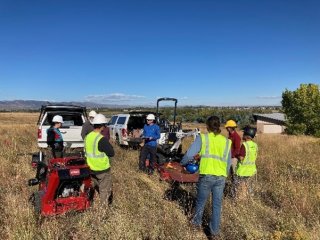Fort Collins, Colorado
Air Monitoring Grant Update
|
Pollutant(s) of Interest |
NOx, Ozone |
|---|---|
|
Primary Objective |
Install a new criteria pollutant monitoring site, which includes a shelter, ozone, NOX, a meteorological tower and meteorological sensors. This information will provide better regional information, including information for Environmental Justice (EJ) communities, regarding ozone exposure. |
|
# of New Devices |
Teledyne API T400 (1), Teledyne APIT200 (1) |
|
Monitoring Device(s) |
Teledyne API T400, Teledyne APIT200 |
|
Primary Grantee |
City of Fort Collins |
|
Key Grant Partners |
Larimer County, CO, Colorado Department of Public Health and Environment (CDPHE), US National Parks Service, Colorado State University, Bird Conservatory of the Rockies |
|
More Information |
For years Fort Collins, Colorado, a medium-sized college town north of Denver, had wanted to stand up a new regulatory air monitoring site. While the city already housed two monitoring facilities, they knew there was room in their network for another federally recognized monitor in the lower-income, eastern parts of the community, to better understand key pollutants, including NOx. Adding a new federally monitoring site is challenging, though, and one that is expensive to both establish and maintain.

Courtesy of City of Fort Collins
With the help of an ARP grant from EPA, Fort Collins Department of Environmental Services partnered with Larimer County and the Colorado Department of Public Health and Environment (CDPHE)—the statewide regulatory entity—to install a new ambient air monitoring station in the Fossil Creek Reservoir Natural Area on the southeastern side of town. The city worked with EPA to procure the equipment through the ARP grant, while also providing the site, and facilitating the challenging permitting and public engagement components of the project. The county became responsible for all equipment and facility maintenance, and CDPHE took on equipment installation, data processing and data utilization. This innovative collaboration created a pathway for the city to stand up the site with a federal grant, and then transfer that site over to the state’s regulatory monitoring network once it is up and running. Data collected at this site will be used as part of the state’s regulatory monitoring network.

Courtesy of City of Fort Collins
What’s been most interesting about this project, however, are the strategic relationships that have developed as a result. Project organizers intentionally selected a city-owned natural area as the location for the new monitoring site, which brought in direct engagement from community members, the city Department of Natural Resources (DNR), the National Park Service, Colorado State University, and wildlife conservation groups like the Bird Conservatory of the Rockies. By bringing this group of stakeholders together, project organizers have helped embed the benefits of air quality monitoring in work across Colorado’s front range—the city DNR has now even added air quality into their strategic planning documents, putting an air quality lens on future natural resource decisions. This project has also helped the city better engage with grass roots advocacy groups and academics advocating for clean air, including conversations about how to better collaborate on both public education and future scientific research.
